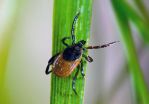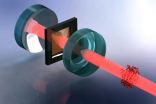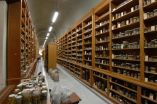(Press-News.org) It's a dog eat dog world, and bacteria have been living in it for a long time. It's of no surprise that bacteria have a sophisticated arsenal to compete with each other for valuable resources in the environment. In 2010, work led by University of Washington Department of Microbiology Associate Professor Joseph Mougous uncovered a weaponry system used in this warfare between bacteria. The combatants inject deadly toxins into rival cells.
Now, in a surprising twist, Mougous and colleagues have found that many animals have taken a page from the bacterial playbook. They steal these toxins to fight unwanted microbes growing in or on them. The researchers describe their findings in a report to be published online Nov. 24 in the journal Nature.
The animal toxins were serendipitously discovered when the Mougous group was working with evolutionary biologist Harmit Malik at Fred Hutchinson Cancer Research Center in Seattle to find more bacterial competition toxins.
"When we started digging into genome databases, we were surprised to find that toxin genes we thought were present only in bacteria were also in several animals," explained co-author Matt Daugherty, a postdoctoral fellow in the Malik lab. "We immediately started wondering why they were there."
Their analyses revealed that these genes had jumped from bacteria into animals. These genes had become permanently incorporated into the genomes of these animals through a process known as horizontal gene transfer. While such transfer events are common between microbes, very few genes have been reported to jump from bacteria to more complex organisms.
The organisms carrying the bacterial toxins were incredibly diverse and included several species of ticks and mites. The team of scientists immediately recognized the potential medical importance of the toxin in one organism in particular - the deer tick, infamous for its ability to transmit Lyme disease.
"We were excited to see this in the deer tick, given the increasing prevalence of Lyme disease in North America. Lyme disease is caused by a bacterium, so we speculated that the transferred antibacterial toxin might affect how the tick interacts with the Lyme disease agent," said co-author Seemay Chou, a postdoctoral researcher in the Mougous group.
Ticks carry pathogens in their guts and transmit them through their saliva when they feed on animals. The toxin was abundant in both of these sites in the tick. The researchers observed that, when they used genetic strategies to reduce production of the toxin in ticks, levels of the Lyme disease pathogen rose significantly.
"We are now following up on these results by looking into how these toxins influence Lyme disease transmission," said Chou.
How the toxins function in organisms other than ticks remains to be explored. The researchers now are looking at the possibility that other bacterial toxins have been repurposed by animals for antibacterial defense.
"Given the rate by which we are discovering new toxins, it would not surprise me at all if we find more that have been horizontally transferred" noted Mougous.
The Nature paper is titled, "Transferred interbacterial antagonism genes augment eukaryotic innate immune function."
INFORMATION:
The research published was funded by the National Institute of Health (AI080609, AI083640), the Defense Threat Reduction Agency (HDTRA-1-13-014), the Biotechnology and Biological Sciences Research Council (BB/I020012/1), with additional support from Howard Hughes Medical Institute.
EAST LANSING, Mich. --- What will it take to convince skeptics of global warming that the phenomenon is real? Surely, many scientists believe, enough droughts, floods and heat waves will begin to change minds.
But a new study led by a Michigan State University scholar throws cold water on that theory.
Only 35 percent of U.S. citizens believe global warming was the main cause of the abnormally high temperatures during the winter of 2012, Aaron M. McCright and colleagues report in a paper published online today in the journal Nature Climate Change.
"Many people already ...
Physicists at the University of Basel have developed a new cooling technique for mechanical quantum systems. Using an ultracold atomic gas, the vibrations of a membrane were cooled down to less than 1 degree above absolute zero. This technique may enable novel studies of quantum physics and precision measurement devices, as the researchers report in the journal Nature Nanotechnology.
Ultracold atomic gases are among the coldest objects in existence. Laser beams can be used to trap atoms inside a vacuum chamber and slow down their motion to a crawl, reaching temperatures ...
Are Italian natural history museums (NHMs) on the verge of collapse? A new analysis published in the open access journal ZooKeys points out that these institutions are facing a critical situation due to progressive loss of scientific relevance, decreasing economic investments and scarcity of personnel.
The study proposes that existing museums associate and collaborate to form a diffused structure, able to better manage their scientific collections and share resources and personnel.
"Italy is universally known for its history, culture, food and art. The list of Italian ...
Scientists from Uppsala University, the Science for Life Laboratory (SciLifeLab) in Stockholm and Uppsala University Hospital have developed a new method of rapidly identifying which bacteria are causing an infection and determining whether they are resistant or sensitive to antibiotics. The findings are now being published in the Journal of Clinical Microbiology.
'Clinical use of the method would mean that the right antibiotic treatment could be started straightaway, reducing unnecessary use of antibiotics,' says Professor Dan I. Andersson of Uppsala University, who ...
HOUSTON - (Nov. 24, 2014) - New computer models that show how microtubules age are the first to match experimental results and help explain the dynamic processes behind an essential component of every living cell, according to Rice University scientists.
The results could help scientists fine-tune medications that manipulate microtubules to treat cancer and other diseases. Rice theoretical biophysicist Anatoly Kolomeisky and postdoctoral researcher Xin Li reported their results in the Journal of Physical Chemistry B.
Microtubules are cylinders made of 13 protein strands ...
People with moderate to severe obstructive sleep apnea may have an intrinsic inability to burn high amounts of oxygen during strenuous aerobic exercise, according to a new study led by researchers at University of California, San Diego School of Medicine.
The study, reported in the current issue of Journal of Clinical Sleep Medicine, shows that people with sleep apnea, in which breathing repeatedly starts and stops during slumber, have a lower peak oxygen uptake during aerobic activity than those who do not suffer from the sleep disorder.
People who suffer from apnea ...
From coral reefs to prairie grasslands, some of the world's most iconic habitats are susceptible to sudden collapse due to seemingly minor events. A classic example: the decimation of kelp forests when a decline of otter predation unleashes urchin population explosions. Three studies published in the Nov. 24 special issue of Philosophical Transactions of the Royal Society Biological Science hold the promise of helping resource managers predict, avoid, and reverse the tipping points that lead to degraded habitats, economic losses, and social upheaval.
The studies are the ...
Good communication between brain cells is vital for optimal (mental) health. Mutations in the TBC1D24 gene inhibit this process, thereby causing neurodegeneration and epilepsy. Fruit flies with a defect in Skywalker, the fruit fly variant of TBC1D24, are being used as a model for neurodegeneration. Researchers from VIB and KU Leuven have succeeded in completely suppressing neurodegeneration in such fruit flies, by partially inhibiting the breakdown of 'defective' proteins in brain cells.
Patrik Verstreken (VIB/KU Leuven): "These unexpected results offer us a new line ...
VIDEO:
High-dose interleukin-2 can be effective in selected metastatic renal cell cancer patients pre-treated with VEGF-targeted agents, reveals research presented today at the ESMO Symposium on Immuno-Oncology in Geneva, Switzerland....
Click here for more information.
Lugano/Geneva, Switzerland, 24 November 2014 - High-dose interleukin-2 can be effective in selected metastatic renal cell cancer patients pre-treated with VEGF-targeted agents, reveals research presented ...
A multi-disciplinary research team from the National University of Singapore (NUS) has made a breakthrough discovery of a new type of immune cells that may help in the development of a future treatment for multiple sclerosis (MS).
Led by Professor Xin-Yuan Fu, Senior Principal Investigator from CSI Singapore and Professor at the Department of Biochemistry at the NUS Yong Loo Lin School of Medicine, and Dr Wanqiang Sheng, post-doctoral fellow at CSI Singapore, the team found that a new type of immune T helper cells named TH-GM cells play a crucial role in the immune system ...






